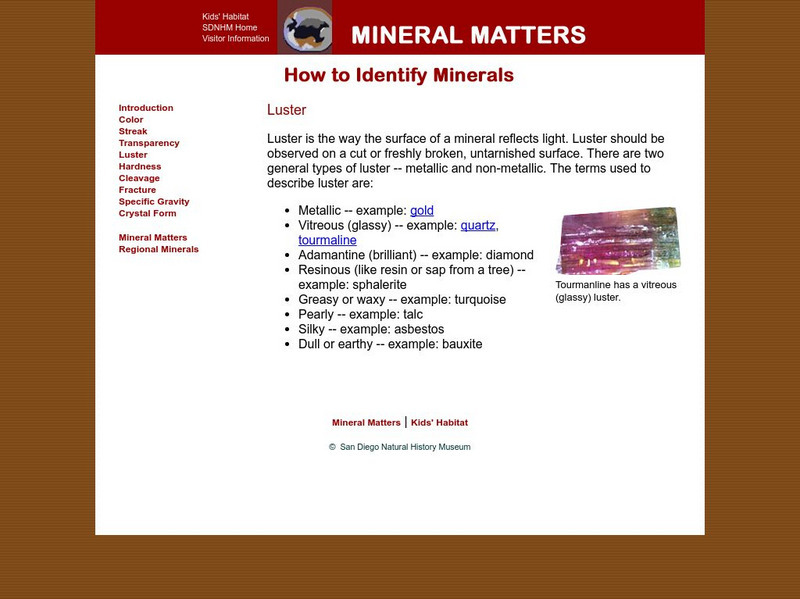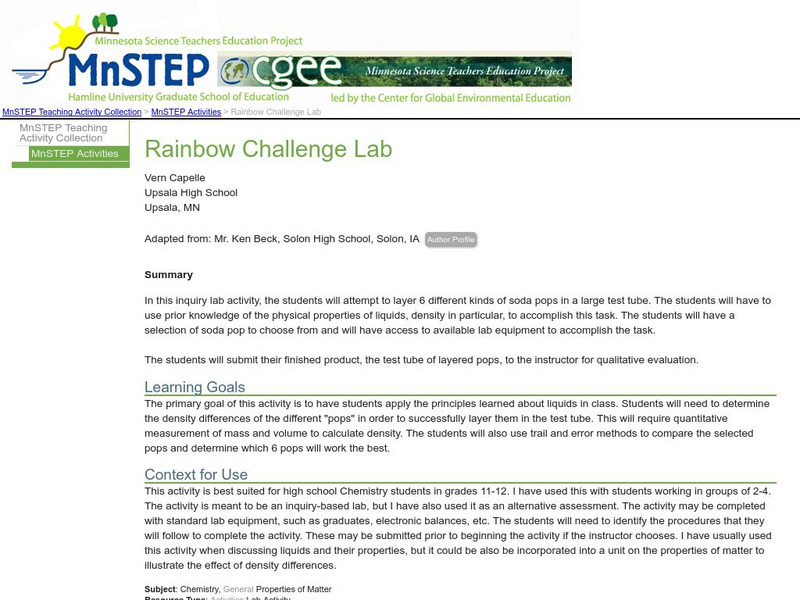Other
King's Centre for Visualization in Science: Scientific Models
A series of interactive applets use scientific models to teach some basic concepts of matter, including states of matter and physical and chemical changes.
Alabama Learning Exchange
Alex: How Sweet It Is
As part of the study of Matter, the students will determine the density of standard percent sugar solutions through hands on experimentation. In laboratory groups, students will graph a standardized curve of the experimental data. The...
PBS
Pbs Learning Media: The Ruff Ruffman Show: Teacher's Guide: Kitchen Chemistry
Learn about kitchen chemistry alongside Ruff Ruffman. Students can use the videos, games, and activities from The Ruff Ruffman Show to discover how by investigating solids and liquids and exploring heating and cooling, science can help...
PBS
Pbs Learning Media: The Ruff Ruffman Show: Ruff's Cookie Creator
Use science inquiry to explore and test different ingredients to help Ruff make, decorate, and serve cookies to his family in this kitchen science game.
San Diego Natural History Museum
San Diego Natural History Museum: Mineral Matters: Luster
A brief introduction to identifying a mineral by its luster. Examples of terms used to describe luster, such as metallic, glassy, and dull are listed.
TeachEngineering
Teach Engineering: Viscous Fluids
Students are introduced to the similarities and differences in the behaviors of elastic solids and viscous fluids. Several types of fluid behaviors are described--Bingham plastic, Newtonian, shear thinning and shear thickening--along...
Other
Science4 Us: Materials
Students use a dichotomous key to sort materials into natural and man-made and sort further using the adjectives rough and smooth; this activity builds both science and language skills as students classify materials and build deeper...
Science Education Resource Center at Carleton College
Serc: Plastic Polymers: Investigating Their Flexibility
Students will use their prior knowledge about changes of matter to develop a hypothesis to test the physical properties of materials such as plastic (polymers) and how its chemical properties allow it to have unique physical properties.
Other
Science Alive: Melting Point Simulation
Percy Julian and Josef Pikl used the fact that melting point-the temperature at which a substance changes from a solid to a liquid-is a characteristic property of a substance to prove that the British chemist Robert Robinson could not...
Other
Rooted and Growing: Kindergarten Science Unit: Objects and Materials [Pdf]
A collection of science lessons where students explore the characteristics of different materials and everyday objects and create their own objects and art. They study the properties of the materials that make them strong, absorptive,...
Science Education Resource Center at Carleton College
Serc: Rainbow Challenge Lab
In this inquiry lab activity, learners will attempt to layer 6 different kinds of soda pops in a large test tube using their knowledge of density and other physical properties of liquids.
TeachEngineering
Teach Engineering: Flocculants: The First Step to Cleaner Water!
Students experience firsthand one of the most common water treatment types in the industry today, flocculants. They learn how the amount of suspended solids in water is measured using the basic properties of matter and light. In...
Science Education Resource Center at Carleton College
Serc: Polymers & Plastics: Classification & Models
Students will use their prior knowledge about changes of matter including physical and chemical changes to examine and categorize various types of plastics (polymers). They will identify how their chemical properties allow them to have...
BBC
Bb Ci Schools: Revisewise Science: Solids, Liquids, Gases
This site contains an interactive activity in which students can learn about the three states of matter. There is also a factsheet that lists numerous properties of liquids, solids, and gases. The factsheet also uses water as an example...
Utah STEM Foundation
Utah Stem Action Center: What's Up With Our Air?
Young scholars will use modeling to understand inversions. Their models will evolve as they gather more information.
California State University
Csudh Project for Chemistry: Mass, Density, and Volume
Use these word problems as a review in the areas of mass, density, and volume.









